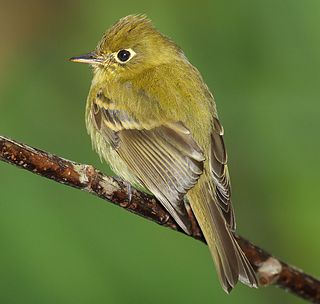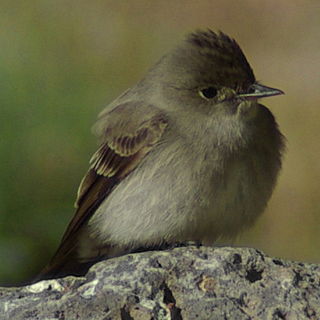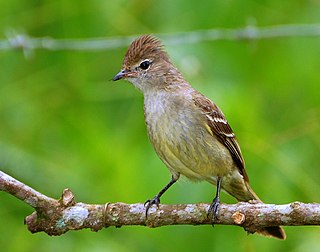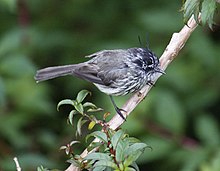
The tyrant flycatchers (Tyrannidae) are a family of passerine birds which occur throughout North and South America. They are considered the largest family of birds known to exist in the world, with more than 400 species. They are the most diverse avian family in every country in the Americas, except for the United States and Canada. The members vary greatly in shape, patterns, size and colors. Some tyrant flycatchers may superficially resemble the Old World flycatchers, which they are named after but are not closely related to. They are members of suborder Tyranni (suboscines), which do not have the sophisticated vocal capabilities of most other songbirds.

The silky-flycatchers are a small family, Ptiliogonatidae, of passerine birds. The family contains only four species in three genera. They were formerly lumped with waxwings and hypocolius in the family Bombycillidae, and they are listed in that family by the Sibley-Monroe checklist. The family is named for their silky plumage and their aerial flycatching techniques, although they are unrelated to the Old World flycatchers (Muscicapidae) and the tyrant flycatchers (Tyrannidae).

The pewees are a genus, Contopus, of small to medium-sized insect-eating birds in the Tyrant flycatcher family Tyrannidae.

Pyrocephalus is a genus of bird in the tyrant flycatcher family, Tyrannidae.

Elaenia is a genus of passerine birds in the tyrant flycatcher family which occur in Mexico, the Caribbean, and Central and South America. Except by voice, specific identification is often difficult since many species are very similar. They are also known by the common name elaenia, which they share with the similar tyrant flycatchers of the genus Myiopagis.

The agile tit-tyrant is a species of bird in the family Tyrannidae, the tyrant flycatchers. It is native to Bolivia, Colombia, Ecuador, and Venezuela.

The tit-tyrants are a group of small, mainly Andean, tyrant flycatchers from the genera Anairetes and Uromyias.

The ash-breasted tit-tyrant is a species of bird in the family Tyrannidae. It is found in Bolivia and Peru.
The Juan Fernández tit-tyrant is a species of bird in the family Tyrannidae. It is endemic to the Juan Fernández Islands in the South Pacific Ocean off Chile. Its natural habitats are subtropical or tropical moist lowland forests, rural gardens, and urban areas. It is threatened by habitat loss.

The yellow-billed tit-tyrant is a species of bird in the family Tyrannidae. It is found in Argentina, Bolivia, Chile, and Peru.

The black-crested tit-tyrant or Marañón tit-tyrant is a species of bird in the family Tyrannidae. It is found in Ecuador and Peru. Its natural habitats are subtropical or tropical moist montane forests and subtropical or tropical high-altitude shrubland.

The tufted tit-tyrant is a species of bird in the tyrant flycatcher family Tyrannidae. This species is found in western South America; its range stretches from southern Colombia south along the Andes mountains to Tierra del Fuego. It prefers to live in upper montane forests and shrublands; however, it is a habitat generalist and can be found across a wide range of ecosystems. The tufted tit-tyrant has three subspecies, including the nominate subspecies Anairetes parulus parulus, A. p. aequatorialis, and A. p. patagonicus, and is very closely related to the Juan Fernández tit-tyrant. It is very small with a distinctive and conspicuous crest. The bird's head is black overall with white supraloral and postocular stripes. Its dull grayish-brown back contrasts with its white throat and breast that are covered with black streaks and pale, unmarked yellow underbelly. There are few noticeable differences in plumage between the subspecies. It is a vocal flycatcher with a broad repertoire of songs.

The pied-crested tit-tyrant is a species of bird in the family Tyrannidae. It is found in coastal Peru and far northern Chile.

Phyllomyias is a genus of small birds in the tyrant-flycatcher family Tyrannidae. They are found in wooded habitats of Central and South America. Some species are among the commonest birds in their range, while other are rare and threatened. They have a short, stubby bill, are greenish above, yellowish or whitish below, and all except the sooty-headed tyrannulet have pale wing-bars or edging. They feed on small arthropods and fruits. Most species regularly take part in mixed species flocks.

Phylloscartes is a genus of small birds in the family Tyrannidae. They are found in wooded habitats of Central and South America. They mainly feed on small arthropods, and most commonly take part in mixed species flocks. The mottled-cheeked tyrannulet is among the commonest birds in its range, but several other species are rare and threatened. Their plumage is predominantly green, yellow, white and grey, and many have contrasting facial patterns and wing-bars. They have thin, pointed bills, and relatively long tails. Most frequently cock their tail, perch relatively horizontally and are very active.

Poecilotriccus is a genus of small flycatchers in the family Tyrannidae. Except for the recently described Johnson's tody-flycatcher, all have, at one point or another, been included in the genus Todirostrum. Some species have been known as tody-tyrants instead of tody-flycatchers. Most species are found in South America, but a single species, the slate-headed tody-flycatcher, is also found in Central America. The black-chested tyrant may also belong in this genus, but most place it in the monotypic genus Taeniotriccus.

Tolmomyias is a genus of Neotropical birds in the tyrant flycatcher family Tyrannidae. It is one of the two genera containing the "flatbills"; the other is Rhynchocyclus.

Pogonotriccus is a genus of small passerine birds in the family Tyrannidae. They are found in wooded habitats of Central and South America.

Uromyias is a genus of small Andean, tyrant flycatchers known as tit-tyrants. They were formerly recognized based on syrinxial and plumage characters, including a flatter crest and a longer tail, but was included within Anairetes due to genetic analysis. Recent analyses suggested splitting into Uromyias again.

Tityridae is family of suboscine passerine birds found in forest and woodland in the Neotropics. The 45 species in this family were formerly spread over the families Tyrannidae, Pipridae and Cotingidae. As yet, no widely accepted common name exists for the family, although tityras and allies and tityras, mourners and allies have been used. They are small to medium-sized birds. Under current classification, the family ranges in size from the buff-throated purpletuft, at 9.5 cm (3.7 in) and 10 grams, to the masked tityra, at up to 24 cm (9.5 in) and 88 grams. Most have relatively short tails and large heads.






















